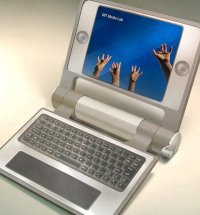$100 laptop risks being too cool for school
 Lee Felsenstein of the Fonly Institute makes an important critique of the OLPC (One Laptop Per Child) project instigated by Massachusettes Institute of Technology.
Lee Felsenstein of the Fonly Institute makes an important critique of the OLPC (One Laptop Per Child) project instigated by Massachusettes Institute of Technology. By marketing the idea to governments and large corporations, the OLPC project adopts a top-down structure. So far as can be seen, no studies are being done among the target user populations to verify the concepts of the hardware, software and cultural constructs. Despite the fact that neither the children, their schools nor their parents will have anything to say in the creation of the design, large orders of multi-million units are planned.It seems another story of the techno-cool factor overriding the first and most important consideration: Is it useful?! (Note: There is no doubt that the laptop MIT developed is very cool and if you didn't see it already, check out the official photographs and the technical specifications)
If it indeed is true that "no studies are being done among the target user populations" then this is extremely worrying and sad for this initiative which definitely has awesome potential. What commercial product is developed without some sort of idea as to whether and how the target users will adopt it? It seems like MIT has done well at what it does best – produce a very sound prototype to fulfil the "$100 laptop pricetag", This is only half of the challenge, though, or perhaps only a quarter! It is absolutely critical that the technology is distributed in an appropriate, effective and sustainable way and backed up by highly sensitive education programs to ensure the laptops are actually useful.
On the face of it, the OLPC project seems to be such a timely, responsible and philanthropic initiative, but Felsenstein reveals a number of potential hardware and usability problems which appear unresolved. Even if MIT denies these issues will be a problem, how can they back up such a claim if they haven't surveyed the target users on the ground to find out how they will use the laptops? How can they know what the greatest challenges will be for these fresh adopters?
The OLPC project needs to move out of technical-development mode and into "social philanthropy" mode to first of all determine the real needs of the end users. Otherwise, we can predict a result somewhat like that of the town of Ennis in Ireland (as related in Mark Warschauer's "Reconceptualizing the Digital Divide").
 Addendum: Two days after my post, MIT unveiled the actual laptop that will be deployed (which looks a bit different to the prototype and appears to have a longer crank handle). Thanks to Dima's comment for the headsup.
Addendum: Two days after my post, MIT unveiled the actual laptop that will be deployed (which looks a bit different to the prototype and appears to have a longer crank handle). Thanks to Dima's comment for the headsup.Technorati Tags: $100 laptop, digital divide, ICT, MIT, WSIS, Lee Felsenstein





6 Comments:
I love the phrase "we will get the fat out of the systems. Today's laptops have become obese. Two-thirds of their software is used to manage the other third, which mostly does the same functions nine different ways."
So do you think a good aim would be to provide a laptop for everyone who wanted one, rather than just everyone? Then (in theory) the children who wanted one would probably be prepared to have them (technologically speaking). Then you have the standard 'i have something you don't' problem, though. However, if you gave them out at school, and taught the children how to use them while at school, then they shouldn't have a major hurdle to pass before they can use them properly.
Though if the computer is wifi enabled, would they be doing any work?
Thought-provoking post Lisa, thanks. Makes a difference from the free bottles of milk we were given as kids at school!
I must admit, reading and thinking about it, i'm more worried than overawed with feelings of gee-whiz.
Apart from what the laptops might be used for in education, they could end up a major distraction (and actually hinder educational processes). Some will break, some kids will try to do clever things (and muck them up in the process), some will simply use them for photos/personal use and time-waste.
At the very least, somebody needs to do the research and figure out the balance of benefit to hindrance.
Are there some educational deficiencies today that a personal laptop would fix? Watching my kid at school, i'm not aware of any, I must say.
They are more IT savvy than most of us (where do they pick it up? I'm thinking it's already got into the gene pool). But mainly it's for entertainment - music, films etc and social life.
Computers are cool, but using them for education? Nope!
It's an important question, Geoff. I would hope though that a laptop/computer for a child isn't just considered purely in terms of its direct educational value but its value as a tool or "interface" which is absolutely necessary to access, manipulate and publish information in the information age!
Obviously though, you can't just throw a fancy laptop at a kid and expect it to be particularly useful beyond the typical time-wasting or education-hindering uses the kids might find for it!
In my humble opinion, the issue is still that of gaps (digital divides if you prefer). There is a great gap between these days school teachers and youth/children who are at ease with technology (well, this is true at least for Israel and Germany, but I guess it is similar elsewhere). So, even if the teachers are not 'afraid' of technology, the current education system still tries to fit utilization of computers into existing boundaries and methods of teaching. I think we are at a stage now, when many paradigms, particularly those concerned with knowledge acquisition and education, have to be reviewed. Don't you think? And of course research is needed to find these new ways to make the most of an opportunity…
BTW, just saw another article about the laptops and there were some pictures available as well. Isn't the device too small? What happens to a person who doesn't have a good vision?
Those pictures are much more up to date than the one I posted of the prototype. I agree the screens are pretty small but I guess the same accessibility options apply on those machines as standard PCs and Apples -- the ability to zoom in on the screen, font size configurability, etc.
If you're designing a website targeted at kids with these laptops don't make it more than about 460 pixels wide though by the looks!
I'm glad to see that the crank handle is a bit longer too -- it might negate Felsenstein's concerns about the amount of energy the kids would need to expend to get it powered up.
Post a Comment
<< Home